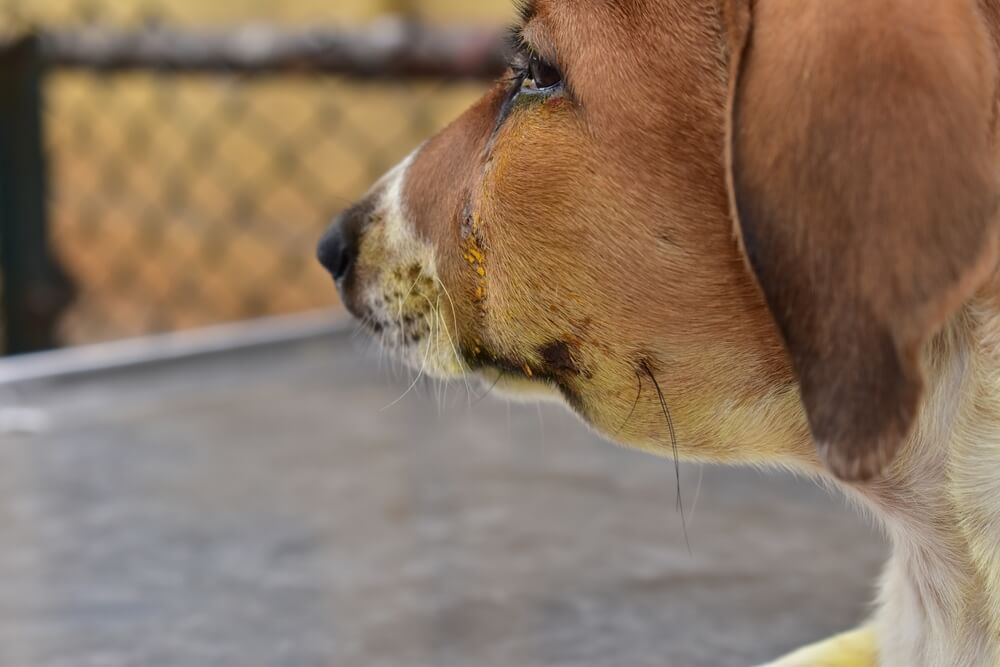Dogs make wonderful companions and indeed are “man’s best friend.” Surveys have found that 6.4 million homes in the United States have dogs as pets, and there are close to 90 million dogs in the country.
Most people feel that their dogs are part of the family. Dogs have moved from backyard pets into our homes. Like children, dogs will occasionally have emergencies that require medical care.
As a veterinarian, I have dogs rushed into my hospital with swollen faces frequently. It can be quite alarming to arrive home and find that your dog’s face is swollen. If your dog suddenly has a swollen face, there are several things that may be causing the issue.
Signs of An Allergic Reaction
The most mentioned complaint from dog owners with dogs who have a swollen face and are experiencing an allergic reaction is that the dog is pawing at its head.1
Other potential signs include:
- swollen eyelids
- swollen ears
- hives
- redness of the eyes
- itchiness
- vomiting or diarrhea
These clinical signs are classic for a dog that is experiencing an allergic reaction. The swelling, itching, and hives indicate that the dog’s immune system is having an exaggerated response to something considered foreign.
The most common causes of an allergic reaction in a dog include2:
- medications
- pollen
- dust
- mold
- food
- insect bites
If the dog has received a vaccination, this too could be a possible cause for their swollen face. Though rare, some dogs will have adverse reactions when vaccinated.34
It is a myth that allergic reactions always occur immediately after the dog has encountered the foreign substance. In fact, though a reaction may occur immediately, it is common for allergic reactions to manifest up to 48 hours later.5
Any allergic reaction can be an emergency, so it is vital to consult your dog’s veterinarian as soon as signs are noticed.
The Severity of Allergic Reactions – Mild to Life-Threatening
Mild Allergic Reactions
In some cases, a dog may have such a mild allergic reaction that the signs may go unnoticed. These types of reactions can consist of a few hives, itchy skin, or a bump and redness where the allergen contacted the dog.6
Some dogs will be mildly lethargic, sore, or even have a fever following vaccinations. These are normal occurrences and are an indicator that the dog’s immune system is responding appropriately to the vaccine. These are not allergic reactions.7
More Severe Allergic Reactions
Suppose you come home and find your dog displaying signs of a more severe allergic reaction, for example, a swollen face, severe itchiness, hives covering their body, or vomiting. In that case, they should be taken to a veterinarian immediately. Treatment will likely be needed.
Though rare, an extremely severe allergic reaction called anaphylaxis can occur when dogs are exposed to specific allergens. Signs of anaphylaxis include all of the signs mentioned above, plus difficulty breathing, shaking, and loss of consciousness.8
If a dog is experiencing true anaphylaxis, it is a life-threatening emergency. Time is of the essence, and emergency treatment must be administered right away. Anaphylaxis can cause failure of the respiratory system and the heart, resulting in death.
Medical Care for Allergic Reactions in Dogs
If you have a dog suspected of having an allergic reaction, you must consult your veterinarian for treatment right away.
Mild allergic reactions may not require any treatment, or they may be treated with simple over-the-counter antihistamines.9 Never administer any medication to your dog without the guidance of a veterinarian.
Dogs are not small humans and have different physiology. Some medications that are safe for humans are toxic to dogs, and those that are safe often have very different doses when given to dogs.10
In the case of a more severe reaction, the veterinarian may administer other medications to aid in your dog’s recovery. These may include:
- intravenous fluids for cardiovascular support
- steroids to halt the allergic reaction
- bronchodilators to improve breathing
- injectable antihistamines to calm the allergic reaction
In severe cases, hospitalization and oxygen therapy may be necessary.11
Identifying the Culprit
Once the dog has been successfully treated and the allergic reaction is under control, it is essential to try to identify what foreign substance caused the reaction in the first place.
The pet’s environment should be inspected for bugs (spiders, ants, bees, and wasps) or any foods or plants the dog may have ingested. Tell your veterinarian about any medications given to the dog or that they may have accidentally ingested. New foods, treats, cleaning products, and laundry detergents should also be investigated.
Prevention of Allergic Reactions
Once a dog has had an allergic reaction, the only way to prevent another is to keep them from encountering the allergen again.
Dogs are curious and playful and can often stick their noses where they don’t belong – literally. Bites and stings from insects can be impossible to prevent, but if there are insects in the dog’s environment, an effort should be made to remove them.
In the rare case of a vaccine reaction, you should discuss the need for additional vaccines with your veterinarian. The risk of the reaction should be weighed against the benefit of the vaccine for the dog. The severity of the reaction, the dog’s age, vaccine status, and its lifestyle should all be considered when deciding on future vaccines.
Dogs with a history of vaccine reaction may be pre-medicated with antihistamines to avoid another reaction.12 Additionally, vaccines for these dogs should be spaced out, and they should only receive one vaccine at a time until the vaccine they are allergic to is discovered.
Any dog with a history of an allergic reaction should be monitored closely after vaccination, following an insect bite or sting, or when being given a new medication.
Final Thoughts
Coming home to discover your beloved pup with a swollen face or other signs of an allergic reaction can be frightening. A veterinarian should always be consulted in these situations.
Remember that true anaphylaxis is a life-threatening emergency. Every dog owner should know what to do in the case of a crisis before it happens. This includes learning how to contact your dog’s veterinarian after hours or where the nearest emergency veterinary hospital is located.
After the reaction has passed, it is essential to identify the trigger so that another reaction can be avoided in the future.
Article Sources
Pet News Daily uses only high-quality sources, including peer-reviewed studies, to support the facts within our articles. Read our editorial process to learn more about how we fact-check and keep our content accurate, reliable, and trustworthy.
- Barnette C, Ward E. Allergies in dogs. Vcahospitals.com. Accessed April 14, 2022.
- Grognet J. Types of allergic reactions in dogs. Akc.org. Published June 21, 2016. Accessed April 14, 2022.
- American Animal Hospital Association. Vaccine adverse reactions. Aaha.org. Accessed April 14, 2022.
- Gershwin LJ. Adverse reactions to vaccination: from anaphylaxis to autoimmunity. Vet Clin North Am Small Anim Pract. 2018;48(2):279-290. doi:10.1016/j.cvsm.2017.10.005
- Animal Emergency Service. Our guide to allergic reactions in dogs. Info.animalemergencyservice.com. Accessed April 14, 2022.
- Lee JA. A quick guide to allergic reactions in dogs. Pethealthnetwork.com. Accessed April 14, 2022.
- American Veterinary Medical Association. What to expect after your pet’s vaccination. Avma.org. Accessed April 14, 2022.
- Lyons JL, Scherk JR. Anaphylactic shock: how to effectively treat and diagnose. Todaysveterinarypractice.com. Published June 9, 2017. Accessed April 14, 2022.
- Tizard I. Disorders involving anaphylactic reactions (type I reactions, atopy) in dogs. Merckvetmanual.com. Updated October 2020. Accessed April 14, 2022.
- Pet Poison Helpline. Top 10 human medications poisonous to pets. Petpoisonhelpline.com. Accessed April 14, 2022.
- Allukian A. Anaphylaxis in dogs and cats. Mspca.org. Accessed April 14, 2022.
- Ford RB. Vaccine adverse events: acute allergic angioedema. Todaysveterinarypractice.com. Published January/February 2013. Accessed April 14, 2022.

